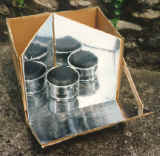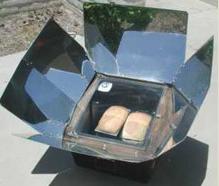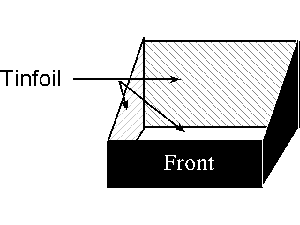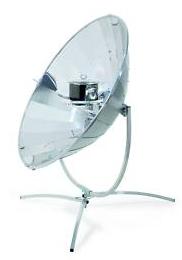
They can be used to cook delicious food, or to dry food for storage. It is possible to cook hot dogs in minutes or even or bake bread or cakes, or to make pizzas and pies. The food cooks slowly and tastes great and best of all – it’s free.
Solar Ovens

Solar Ovens work by simply concentrating the suns rays on a small area using mirrors, a lens, or a reflective surface. The generated heat is then trapped in an enclosed area where it can be absorbed by food contained in dark painted glass jars or pans, or even cooking bags.
Solar cooking was developed in Europe and India in the 1700’s when developments in glass making made glass available to trap heat in a simple solar oven. As long as it is sunny, or even if it is a little cloudy, you can cook in a solar oven even if the ambient air temperature is below zero. On a hot sunny day 10 lbs of food can be cooked with a medium sized solar oven. There is no need to worry about stirring anything, just ensure the solar oven is turned to face directly into the sunlight.
Make a Simple Solar Oven

Pictured above is a schematic of a simple solar cooker. Take a thick strong cardboard box and trim it as shown so that the front is half the height of the back of the box. Next use newspaper as an insulator to hold heat in the box. Staple it in position or use duct tape. Now stick aluminium foil around all the inner surfaces of the box (shiny side out) letting it overlap the box. In this way the foil can be taped in place on the outside of the box where it will not cast a shadow. Finally paint the outside of the box black to help it to absorb heat.
In order to retain the heat in the box a lid is required. Use either a clear sheet of plastic wrap – the type used to cover school books and in craftwork. Stick two layers together to make one piece (sticky sides stuck together) and tape one of the edges to the back of the backside of the box. The lid can then be closed by hanging a weight from the front of the plastic to prevent the lid from blowing off if there is any wind.
It is not necessary to add water to fresh vegetables, but it must be added as normal to cook dried goods (e.g. rice, beans, lentils etc). Ideally use a few small pots rather than one large pot as the food will cook more quickly, and paint them all black (or wrap them in black material) to maximise heat absorption.
The back of the oven is the hottest, so put food which take the longest time to cook at the back. Chicken and fish for example take a couple of hours to cook, lentils three hours, and kidney beans four to five hours. You’ll need to experiment. If you want to to bake in your solar oven then put it in the sun early in the day to give it a chance to heat up well. Ideally cook in the middle of the day when the sun is strongest.
If this all sounds like too much work for you, then you can even cook sausages in an opened out Pringles tube!

It is now possible to buy solar ovens and component parts to build your own solar oven online. Click here for a range of solar ovens etc.